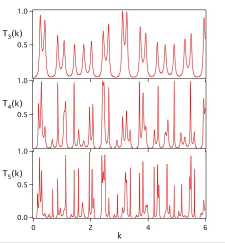Quantum Graphs : Physics of Quantum Singularity (7-2)
|
Scale Invariant Subfamily and Macroscopic Quantum Chaos 2
The scale invariant probablistic reflection of this interaction causes a kind of stochastic property to the scattering process of this interaction. One result of that property is shown in Fig. 5. Here we plot the transmission probability as a function of incident momentum of a quantum particle through N aligned scale invariant point interactions each placed at x = s_1, x = s_2, ..., x = s_N. The s_i are chosen so that the distaces between two point interactions are all mutually incommensuate. With increasing N, the scattering exhibits very typical symptoms of "quantum irregular scatterings". Magic of scale invariance ibrings about the quantum chaos at all energies, to a system whose classical counterpart nothing but fully integrable. Interestingly, system is fully solvable quantum mechanically becasue of the simpleness of boundary condition. For example, in the case of N=2, 3 and 4, the transmission amplitude is given by
whose extension to general N can be easily guessed. One of the thing this model reveals is the fact that what we have known as "quantum chaotic scattering" is nothing but multi-periodic function with tyhe number of period in the order of 2^N. Except for the limit of N-> infinity, this is qualitatively different from classical chaos whose number of periods is infinite. On the other hand, exponetial increase of number of quantum period is a sign of quick approach to the real chaos in quantum irregular scattering, showing the intricacy of the phenomena.
When quantum chaos is discussed, it invariably involves the eigenvalue distribution statistics. More specifically, discussion centers around the level spacing distribution which moves from "Poisson type" to "Wigner type" (or "GOE type") as classical system purportedly goes from integrable to chaotic limit. Here in our model also, if we dicretize the system by imposing, or example, a periodic boundary condition for a finite line, a similar transition can be observed as one increase the number of scatterers N, which can be shown with energies calculated from fully solvable closed equation similar to (7.4).
|
|
|
